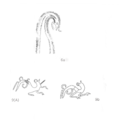 Archaeological map of the archaic center of Poggio Sommavilla Archaeological map of the archaic center of Poggio Sommavilla | |
| Location | Comune di Collevecchio |
|---|---|
| Region | Lazio |
| Type | Settlement |
| History | |
| Periods | Prehistory, Bronze Age, Iron Age, Archaic |
| Site notes | |
| Excavation dates | yes |
| Public access | yes |
The archaeological area of Poggio Sommavilla is an archaeological site located in Poggio Sommavilla, a Frazione of the Comune of Collevecchio in the Tiber valley.
History

In the archaeological area of Poggio Sommavilla, archaeological finds from prehistory, the Bronze Age and the Iron Age have been found on the Tiber river terraces. Of greater consistency is the archaic period settlement whose name is not known, according to the studies of the data collected it had life and development at least from the prehistoric age up to the Hellenistic age, probably up to the time of its destruction by of the Roman republican army led by the consular tribune Marcus Furius Camillus of Veii, Capena and Falerii Veteres, cities with which it had intense continuity of relations throughout its cultural history.
Prehistoric era

The morphological entity of the river terrace of Poggio Sommavilla-Grappignano at the confluence of the Tiber and the Aia torrent in front of the Treja (Paleotevere), geologically made up of gravelly-sandy deposits, undoubtedly constitutes the area that boasts the greatest density and the most relevant deposits of the Tiber valley south of the confluence with the Nera, during Prehistory in the Paleolithic period. The importance of the natural resources of the area, which combines extensive cultivated plains with an abundance of water resources identifiable with the presence of two water courses of significant flow such as the Tiber and L'Aia in front of the Treja river (Paleotevere), as well as with the ditches of Colle Rosetta and Grappignano, it certainly had a decisive impact on habitat choices in prehistoric times. The deposits of the Paleolithic period, with stratification in all three phases of the period, identified in the localities of Grappignano and Colli Oti in Poggio Sommavilla, the lithic industry deposits, can be considered a single settlement area. An area of lithic industry is attested in the Colli Oti of Poggio Sommavilla, chronologically representing all the phases of the Paleolithic, located mainly on the plateau at the top of the westernmost hill of the Colli Oti, with an estimated surface area of approx. 1000 m2. Finished lithic tools are found on the ground, many of which can be classified as scrapers, spearheads, arrows, processing matrices, as well as splinters of processing waste. Lithic tools and processing flakes relating to the Middle Paleolithic have been found in an area of approx. 100 m of extension located on the southern slopes of the hill on which the historic center of Poggio Sommavilla currently stands, on the land Fondo Moreschi, which extends along the current Via La Valle.
Museum

Most of the finds are preserved in Civic archaeological museum of Magliano Sabina, at the National Etruscan Museum of Villa Giulia in Rome and at the National Archaeological Museum of Florence in Rieti and in many parts of the world, some are preserved in the Museum of Fine Arts in Boston including the Fiaschetta di Poggio Sommavilla and at the Ny Carlsberg Glyptotek Museum in Copenhagen. Two red-figure chalice kraters are on display at the Archaeological Museum of Parma.
Fiaschetta di Poggio Sommavilla
Fiaschetta pendaglio amuleto of Poggio Sommavilla is a small brown body vase with an inscription from the 7th century BC. belonged to a woman, and found in 1895 in the funerary objects of Tomb III in the Necropolis of the archaic center of Poggio Sommavilla.
Fantastic Bestiary
From the fantastic animals engraved in the finds of the necropolis of the archaic center of Poggio Sommavilla, very close analogies emerge with the materials from the Capenate and Faliscan areas. With these we discuss clear contacts with Etruscan ceramics, geometric ceramics - dating back to an older phase - and contemporary Etruscan-Corinthian ceramics: common elements appear both in the choice of subjects and in the rendering of the zoomorphic friezes. Tomb 3 of Poggio Sommavilla released a grave goods characterized by decorative plant units and attributable to a single local workshop, equiniform figures prevail, similar ones were found on ollas in the Giglio necropolis of Magliano.
Gallery
-
 Prehistoric Paleolithic finds of lithic industry, Poggio Sommavilla-Grappignano, Tiber Valley
Prehistoric Paleolithic finds of lithic industry, Poggio Sommavilla-Grappignano, Tiber Valley
-
 Tomb kit III Necropolis of Poggio Sommavilla, excavations of 1896.
Tomb kit III Necropolis of Poggio Sommavilla, excavations of 1896.
-
 Red-figure chalice krater, sphinx among satyrs dancing and playing the lyre, 5th century. B.C. tomb V necropolis of Poggio Sommavilla, Archaeological Museum of Parma
Red-figure chalice krater, sphinx among satyrs dancing and playing the lyre, 5th century. B.C. tomb V necropolis of Poggio Sommavilla, Archaeological Museum of Parma
-
 Archaeological map - Falerii e la sua regione rivelata dai sepolcreti, Mancinelli Scotti Francesco - Biblioteca Comunale Civita Castellana.
Archaeological map - Falerii e la sua regione rivelata dai sepolcreti, Mancinelli Scotti Francesco - Biblioteca Comunale Civita Castellana.
-
 Column krater, red-figure pottery, musicians with zither, tomb IV 490-470 BC Poggio Sommavilla necropolis, Harvard Art Museums - Fogg Art Museum - United States of America.
Column krater, red-figure pottery, musicians with zither, tomb IV 490-470 BC Poggio Sommavilla necropolis, Harvard Art Museums - Fogg Art Museum - United States of America.
-
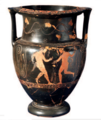 Column krater, red-figure pottery, satyr dances 375-350 BC, tomb 32, Poggio Sommavilla necropolis, SBALazio, southern Etruria.
Column krater, red-figure pottery, satyr dances 375-350 BC, tomb 32, Poggio Sommavilla necropolis, SBALazio, southern Etruria.
-
 Kylix with big eyes decorated with a Satyr in the centre, Necropolis of Poggio Sommavilla, Tomb 43.
Kylix with big eyes decorated with a Satyr in the centre, Necropolis of Poggio Sommavilla, Tomb 43.
-
 Decorated aryballos, Etruscan Corinthian pottery, Necropolis of Poggio Sommavilla excavations of 1896, National Museum of Denmark.
Decorated aryballos, Etruscan Corinthian pottery, Necropolis of Poggio Sommavilla excavations of 1896, National Museum of Denmark.
-
 Red-figure kylix, Satyr with leopard skin and Thyrsus V a. C. tomb 48, Necropolis of Poggio Sommavilla.
Red-figure kylix, Satyr with leopard skin and Thyrsus V a. C. tomb 48, Necropolis of Poggio Sommavilla.
-
 Kantharos with stylized horse engraved on brown body ceramic, excavations of 1896, Necropolis of Poggio Sommavilla.
Kantharos with stylized horse engraved on brown body ceramic, excavations of 1896, Necropolis of Poggio Sommavilla.
-
 Red-figure pelike with female figures observing a pomegranate, attributed to the Sommavilla Painter of the 5th century BC. Etruscan Museum "Caludio Faina" Orvieto.
Red-figure pelike with female figures observing a pomegranate, attributed to the Sommavilla Painter of the 5th century BC. Etruscan Museum "Caludio Faina" Orvieto.
-
 Red-figure kylix, medallion with armed Nero VI BC Tomb II Necropolis of Poggio Sommavilla, Louvre Paris.
Red-figure kylix, medallion with armed Nero VI BC Tomb II Necropolis of Poggio Sommavilla, Louvre Paris.
-
 Kylix, red-figure ceramic, Leopard Panther, 525-475 BC Poggio Sommavilla necropolis, Musée du Louvre.
Kylix, red-figure ceramic, Leopard Panther, 525-475 BC Poggio Sommavilla necropolis, Musée du Louvre.
-
 Bucchero amphora with reliefs of horses of "Sommavillana" production 6th century BC. C. tomb 32 Necropolis of Poggio Sommavilla.
Bucchero amphora with reliefs of horses of "Sommavillana" production 6th century BC. C. tomb 32 Necropolis of Poggio Sommavilla.
-
 Red-figure kylix, female male pair 6th BC tomb 48 Necropolis of Poggio Sommavilla, SBALazio Etruria meridionale, Roma.
Red-figure kylix, female male pair 6th BC tomb 48 Necropolis of Poggio Sommavilla, SBALazio Etruria meridionale, Roma.
-
 Tomb kit The Necropolis of Poggio Sommavilla, excavations of 1896
Tomb kit The Necropolis of Poggio Sommavilla, excavations of 1896
-
 Red-figure craters 5th BC tomb V necropolis of Poggio Sommavilla Archaeological Museum of Parma
Red-figure craters 5th BC tomb V necropolis of Poggio Sommavilla Archaeological Museum of Parma
-
 Oinochoe with gray body, with equine decorations 6th century. BC Tomb 48, Poggio Sommavilla Necropolis.
Oinochoe with gray body, with equine decorations 6th century. BC Tomb 48, Poggio Sommavilla Necropolis.
-
 Fiaschetta pendaglio amuleto 7th century BC with inscription, necropolis of Poggio Sommavilla, tomb III, side A.
Fiaschetta pendaglio amuleto 7th century BC with inscription, necropolis of Poggio Sommavilla, tomb III, side A.
-
 Fiaschetta pendaglio amuleto 7th century BC with inscription, Poggio Sommavilla necropolis, tomb III, profile.
Fiaschetta pendaglio amuleto 7th century BC with inscription, Poggio Sommavilla necropolis, tomb III, profile.
-
 Tomb 14 necropolis of Poggio Sommavilla, section and plan on paper, archivio SBALazio Etruria meridionale.
Tomb 14 necropolis of Poggio Sommavilla, section and plan on paper, archivio SBALazio Etruria meridionale.
-
 Inscription in Faliscan language, rock necropolis of Foglia, Tiber Valley
Inscription in Faliscan language, rock necropolis of Foglia, Tiber Valley
-
 Archaeological map - Falerii e la sua regione rivelata dai sepolcreti, Mancinelli Scotti Francesco - Biblioteca Comunale Civita Castellana.
Archaeological map - Falerii e la sua regione rivelata dai sepolcreti, Mancinelli Scotti Francesco - Biblioteca Comunale Civita Castellana.
-
 Falerii e la sua regione rivelata dai sepolcreti, archaeological map by Mancinelli Scotti.
Falerii e la sua regione rivelata dai sepolcreti, archaeological map by Mancinelli Scotti.
-
 Alabastron with swans, Etruscan Corinthian ceramic Necropolis of Poggio Sommavilla.
Alabastron with swans, Etruscan Corinthian ceramic Necropolis of Poggio Sommavilla.
-
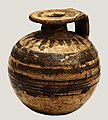 Globular aryballos, Etruscan Corinthian ceramic, Poggio Sommavilla necropolis.
Globular aryballos, Etruscan Corinthian ceramic, Poggio Sommavilla necropolis.
-
 Alabastron, Etruscan Corinthian ceramic, running dogs, tomb 27 Poggio Sommavilla necropolis, archivio SBALazio Etruria Meridionale.
Alabastron, Etruscan Corinthian ceramic, running dogs, tomb 27 Poggio Sommavilla necropolis, archivio SBALazio Etruria Meridionale.
-
 Alabastron, Etruscan-Corinthian ceramic motif of running dogs, Poggio Sommavilla necropolis Archaeological Museum Florence.
Alabastron, Etruscan-Corinthian ceramic motif of running dogs, Poggio Sommavilla necropolis Archaeological Museum Florence.
-
 Alabastron, Etruscan-Corinthian ceramics, Poggio Sommavilla necropolis, Archaeological Museum of Florence.
Alabastron, Etruscan-Corinthian ceramics, Poggio Sommavilla necropolis, Archaeological Museum of Florence.
-
 Glass paste aryballos, Etruscan Museum of Villa Giulia, Rome.
Glass paste aryballos, Etruscan Museum of Villa Giulia, Rome.
-
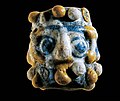 Glass paste necklace, tomb 1, 4th BC Necropolis of Poggio Sommavilla, archivio SBALazio Etruria meridionale.
Glass paste necklace, tomb 1, 4th BC Necropolis of Poggio Sommavilla, archivio SBALazio Etruria meridionale.
-
 Kilyx, red-figure pottery 480 BC tomb 39, Poggio Sommavilla necropolis, archivio SBALazio Etruria Meridionale.
Kilyx, red-figure pottery 480 BC tomb 39, Poggio Sommavilla necropolis, archivio SBALazio Etruria Meridionale.
-
 Planimetry of tomb 36, Poggio Sommavilla necropolis, archivio SBALazio Etruria Meridionale.
Planimetry of tomb 36, Poggio Sommavilla necropolis, archivio SBALazio Etruria Meridionale.
-
 Tomb 36, Poggio Sommavilla necropolis, archivio SBALazio Etruria Meridionale.
Tomb 36, Poggio Sommavilla necropolis, archivio SBALazio Etruria Meridionale.
-
 Tomb of the ara dei Gelsi, Poggio Sommavilla necropolis, SBALazio Etruria meridionale
Tomb of the ara dei Gelsi, Poggio Sommavilla necropolis, SBALazio Etruria meridionale
-
 Excavations of grave 48, Poggio Sommavilla necropolis, archivio SBALazio Etruria Meridionale.
Excavations of grave 48, Poggio Sommavilla necropolis, archivio SBALazio Etruria Meridionale.
-
 Lebes Greek ceramic, tomb of the ara dei Gelsi, Poggio Sommavilla necropolis SBALazio etruria meridionale.
Lebes Greek ceramic, tomb of the ara dei Gelsi, Poggio Sommavilla necropolis SBALazio etruria meridionale.
-
 Boar-shaped balsam jar, tomb II necropolis of Poggio Sommavilla Archaeological Museum Florence.
Boar-shaped balsam jar, tomb II necropolis of Poggio Sommavilla Archaeological Museum Florence.
-
 Kylix, red-figure ceramic, tomb 2 Poggio Sommavilla necropolis, Florence Archaeological Museum.
Kylix, red-figure ceramic, tomb 2 Poggio Sommavilla necropolis, Florence Archaeological Museum.
-
 Kylix, red-figure ceramic, tomb II necropolis of Poggio Sommavilla, Archaeological Museum of Florence.
Kylix, red-figure ceramic, tomb II necropolis of Poggio Sommavilla, Archaeological Museum of Florence.
-
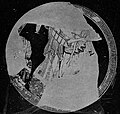 Kilyx erotica, medallion, red-figure pottery, 500-450 BC Necropolis of Poggio Sommavilla, Oxford Museum
Kilyx erotica, medallion, red-figure pottery, 500-450 BC Necropolis of Poggio Sommavilla, Oxford Museum
-
 Attic red-figure kilyx, women with garland and sprig and young people with bags - 490-480 BC. necropolis of Poggio Sommavilla, production: Athens - potter: HIERON EPOIESEN - painter: Makron, Cambridge Museum Oxford
Attic red-figure kilyx, women with garland and sprig and young people with bags - 490-480 BC. necropolis of Poggio Sommavilla, production: Athens - potter: HIERON EPOIESEN - painter: Makron, Cambridge Museum Oxford
-
 Attic red-figure kilyx, women with garland and sprig and young people with bags - 490-480 BC. necropolis of Poggio Sommavilla, production: Athens - potter: HIERON EPOIESEN - painter: Makron, Cambridge Museum Oxford
Attic red-figure kilyx, women with garland and sprig and young people with bags - 490-480 BC. necropolis of Poggio Sommavilla, production: Athens - potter: HIERON EPOIESEN - painter: Makron, Cambridge Museum Oxford
-
 Erotic red-figure ceramic kylix, with inscription on the left handle ιερον εποιεσεν, 500-450 BC. Necropolis of Poggio Sommavilla, Oxford Museum
Erotic red-figure ceramic kylix, with inscription on the left handle ιερον εποιεσεν, 500-450 BC. Necropolis of Poggio Sommavilla, Oxford Museum
-
 Red-figure ceramic erotic kylix, 500-450 BC Necropolis of Poggio Sommavilla, Oxford Museum
Red-figure ceramic erotic kylix, 500-450 BC Necropolis of Poggio Sommavilla, Oxford Museum
-
 Stamnos by the Sommavilla Painter, red-figure ceramic, naked boys, 5th BC Necropolis of Genoa, Civic Archaeological Museum Genoa Pegli.
Stamnos by the Sommavilla Painter, red-figure ceramic, naked boys, 5th BC Necropolis of Genoa, Civic Archaeological Museum Genoa Pegli.
-
 Sun rises between six satyrs, drawing of the decoration of a red-figure ceramic krater 380-360 BC. Necropolis of Poggio Sommavilla, Archaeological Museum of Parma.
Sun rises between six satyrs, drawing of the decoration of a red-figure ceramic krater 380-360 BC. Necropolis of Poggio Sommavilla, Archaeological Museum of Parma.
-
 Olla from the fantastic bestiary, excision of fantastic animals, tomb II VI BC necropolis of Poggio Sommavilla, archivio SBALazio Museo Civico Rieti.
Olla from the fantastic bestiary, excision of fantastic animals, tomb II VI BC necropolis of Poggio Sommavilla, archivio SBALazio Museo Civico Rieti.
-
 Bronze elements, Poggio Sommavilla necropolis archivio SBALazio etruria meridionale.
Bronze elements, Poggio Sommavilla necropolis archivio SBALazio etruria meridionale.
-
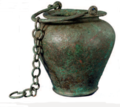 Bronze situla VI V BC tomb 32, Poggio Sommavilla necropolis archivio SBLazio etruria meridionale
Bronze situla VI V BC tomb 32, Poggio Sommavilla necropolis archivio SBLazio etruria meridionale
-
 Amphora with decoration impressed on small cylinders, locally produced, tomb in the Poggio Sommavilla necropolis Archivio Soprintendenza Archeologia del Lazio e dell'Etruria Meridionale
Amphora with decoration impressed on small cylinders, locally produced, tomb in the Poggio Sommavilla necropolis Archivio Soprintendenza Archeologia del Lazio e dell'Etruria Meridionale
-
 Memorial stone of African freedom, of the Pacci, courtyard of the Cicignano crossroads building and the local historian avv. Umberto Mattei
Memorial stone of African freedom, of the Pacci, courtyard of the Cicignano crossroads building and the local historian avv. Umberto Mattei
-
 Roman inscription in the courtyard of the Cicignano crossroads block
Roman inscription in the courtyard of the Cicignano crossroads block
-
 Toccia ruins, arched door on the tuff spur, area of the archaic Votive Well, Ponte del Peccato, valley of the Aia stream, Grappignano Poggio Sommavilla.
Toccia ruins, arched door on the tuff spur, area of the archaic Votive Well, Ponte del Peccato, valley of the Aia stream, Grappignano Poggio Sommavilla.
-
 Grappignano, archaeological area
Grappignano, archaeological area
-
 Ancient roads, aerial bombing of RAF Grappignano
Ancient roads, aerial bombing of RAF Grappignano
-
 Marble bas-relief of a plumed helmet, Casone Collevecchio, provenance of the Colli monument
Marble bas-relief of a plumed helmet, Casone Collevecchio, provenance of the Colli monument
-
 Torre Romana with construction of a severed boundary, Colli road Fosso del Barcone, Madonna del Piano fountain, valley of the Aia stream, Collevecchio-Poggio Sommavilla
Torre Romana with construction of a severed boundary, Colli road Fosso del Barcone, Madonna del Piano fountain, valley of the Aia stream, Collevecchio-Poggio Sommavilla
-
 VICCIANA tile stamp. DF. STATONIE. common Roman burial ground of the freedman Satrino, station road. of Poggio Sommavilla, preserved in the Municipality of Collevecchio
VICCIANA tile stamp. DF. STATONIE. common Roman burial ground of the freedman Satrino, station road. of Poggio Sommavilla, preserved in the Municipality of Collevecchio
-
 Statue of Tranquillina, tfound by a farmer near the locality known as the dei Frati north of the current historic center of Poggio Sommavilla
Statue of Tranquillina, tfound by a farmer near the locality known as the dei Frati north of the current historic center of Poggio Sommavilla
-
 Castri Summa Villa Chronicon 33 di Benedetto del Soratte p. 46
Castri Summa Villa Chronicon 33 di Benedetto del Soratte p. 46
-
 Basements (Basolati) on a floodplain embankment of the Tiber, Campo Rampone, Poggio Sommavilla archaeological area, Tiber Valley
Basements (Basolati) on a floodplain embankment of the Tiber, Campo Rampone, Poggio Sommavilla archaeological area, Tiber Valley
-
 Poggio Sommavilla Poggetto, current historical center, archaeological area
Poggio Sommavilla Poggetto, current historical center, archaeological area
See also
References
- Centro arcaico
- Paola Santoro, Rilettura critica della necropoli di Poggio Sommavilla, Roma, 1977, p. 20
- ^ "Museo Civico Archeologico di Magliano Sabina". Archived from the original on 2019-08-29.
- ^ Flaminia Verga, Ager Foronovanus I, Forma Italiae 44, pp. 50, 75, 77
- ^ Massimo Ernesto Santucci, archeologo paleontologo, locale, ha consegnato dopo ricognizioni archeologiche in loco, materiali paleoarcheologici e preistorici al Museo Civico Archeologico di Magliano Sabina
- Paleo-Tiber
- "PaleoTevere". www.parchilazio.it (in Italian). Retrieved 2024-08-05.
- Flaminia Verga, Ager Foronovanus I, Forma Italiae 44, p. 77
- Flaminia Verga, Ager Foronovanus I, Forma Italiae 44, p. 50
- Flaminia Verga, Ager Foronovanus I Forma Italiae 44, pag 75
- Museo Civico Archeologico di Magliano Sabina Preistoria Archived 2019-08-29 at the Wayback Machine
- "Small canteen-shaped vase with inscription". Museum of Fine Arts, Boston. Archived from the original on 2018-09-17. Retrieved 2019-01-19.
- The amulet pendant flask
- "it".
- Nel quadro molto articolato delle scritture attestate nella seconda metà del VII secolo a.C. nell'Etruria meridionale e nel Lazio, l'iscrizione di Poggio Sommavilla mostra affinità con l'area falisco-veiente-capenate, sigma a quattro tratti e forma della ypsilon (Mauro Cristofani), Santoro, p. 104
- M. Cristina Biella, Lucio G. Perego, Enrico Giovanelli, Il bestiario fantastico di età orientalizzante nella penisola italiana p, 147-153
- Trafugata nel 1994 a Tivoli nei magazzini della Sovraintendenza archeologica del Lazio e dell'Etruria meridionale, apparse nel 1995 sulla copertina del catalogo d'asta inglese Sotheby's, fu acquistata da un certo Zimmermann e trovata nel 2000 nella collezione privata della propria abitazione in Germania, dove non è stato possibile verificare il possesso e la provenienza di altri reperti archeologici.
- Soprintendenza Archeologica del Lazio e dell'Etruria meridionale Home - Soprintendenza archeologia, belle arti e paesaggio per l'area metropolitana di Roma, la provincia di Viterbo e l'Etruria meridionale http://sabap-rm-met.beniculturali.it/
- Tra il n. 63 e il n. 64 sulla Carta Archeologica di Flaminia Verga.
- Fitzwilliam Museum GR.12.1927 - John D. Beazley,, Oxford 1963, 468, 144 - Norbert Kunisch, Makron, Mainz 1997, cat. 143, scena A.
- Fitzwilliam Museum GR.12.1927 - John D. Beazley,, Oxford 1963, 468, 144 - Norbert Kunisch, Makron, Mainz 1997, cat. 143, scena b.
- ^ Umberto Mattei, La Sabina tiberina dalla preistoria alla fine dell'impero romano, 2004 p, 102
- ^ CIL IX 4827 4828 Corpus Inscriptionum Latinarum - volume XI, Mommsen Theodor - 1883 https://www.trismegistos.org/text/553299
- Chronicon 33 di Benedetto del Soratte p. 46, https://archive.org/stream/fonti per la storia d'italia
- N.90 on the Archaeological Map of Flaminia Verga
- Umberto Mattei, Storia di Collevecchio sede della diocesi e della provincia di Sabina, 2004
- foto tratta da Flaminia Verga, Ager Foronovanus I Forma Italiae, vol. 44. 2006
- Umberto Mattei, La Sabina tiberina dalla preistoria alla fine dell'impero romano, 2004 p, 70
- N.42 on the Archaeological Map of Flaminia Verga
- Pasqui descrive la Torre Romana e dei resti di Emplèkton Opus Ceamenticium ora non più visibili, a circa m 1 dal suolo a basa quadrata di circa 3,80 che si trovava tra la Torre e la strada a fianco di un avvallamento, Pasqui Carta Archeologica pp. 347-348
- Si suppone sia stato parte di un insediamento a pianta militare romana poi sede di un Foro Romano di epoca repubblicana, dopo la distruzione del centro arcaico di Poggio Sommavilla. Umberto Mattei, La Sabina tiberina dalla preistoria alla fine dell'impero romano, 2004 p, 56
- Reggiani considera la Torre un resto di mausoleo romano di tipo a Torre sul tracciato viario che dalla Flaminia attraverso la valle del Tevere seguendo la valle del torrente Aia va a Forum Novum a circa 10 km, in Reggiani 180b, p 10, fig 10
- Prende il nome dall'omonima via del Barcone o Balcone, luogo che fino alla meta' del 1900 era utilizzato come aia collettiva dove veniva stipato il grano in così detti Barconi
- Umberto Mattei, La Sabina tiberina dalla preistoria alla fine dell'impero romano, 2004 p, 59
- Le statue di Gordiano III e altre provenienti da Poggio Sommavilla, probabilmente furono collezionate dal gesuita tedesco Athanasius Kircher nel 1600 e tramite la collezione Khircheriana sono patrimonio oggi del Museo Nazionale Romano. Umberto Mattei, La Sabina tiberina dalla preistoria alla fine dell'impero romano, 2004 p, 103
- Notizie degli scavi di antichità (1876–1891) p, 282 https://archive.org/stream/notiziedegliscav13realrich/notiziedegliscav13realrich_djvu.txt
- "Accademia dei Lincei, 1916, Serie quinta, Notizie degli Scavi di Antichita', Volume XIII, Poggio Sommavilla, pag 281, F. Fornari" (PDF).
- «Fundum Antiscanis, vinealis petite sex, toti in massa de Tocie petite de tera hubi dicutur a Saline, tres petite de terra a fundum Antiscanu a Monumento usque ad ripam castri Summa villa, fundum Antiquum cum aliis nominibus integro, fundum Casali hubi est ecclesia Sancti Valentini, cum fundu Carpiniano, fundum Musiniano cum omnia sua adiacentia»
Bibliography
- Stefania Quilici Gigli, Il Tevere e le altre vie d'acqua del Lazio antico (Quaderni di archeologia etrusco italica), Roma, CNR, 1986
- Flaminia Verga, Ager Foronovanus I (Forma Italiae, 44), Firenze 2006
- Paola Santoro (a cura di), Rilettura critica della necropoli di Poggio Sommavilla, Pisa-Roma 1977
- Paola Santoro, Poggio Sommavilla: note sull'insediamento arcaico, Vol. 43, Tomo Primo, Miscellanea etrusca e italica in onore di Massimo Pallottino (1991)
- Filippo Materazzi, Rilettura del centro sabino di Poggio Sommavilla. La storia, la topografia, la famiglia Piacentini, Archeologia Classica LXXIII, 2022.
- A. Pasqui - A. Cozza - F. Bernabei - G.F. Gammurrini, Antichità del Territorio Falisco esposte al Museo Nazionale Etrusco di Villa Giulia (Monumenti Antichi)
- M. Pallottino, Stirpi e Lingue nel Lazio e intorno al Lazio in eta' arcaica (Etruria e Lazio arcaico)
- Umberto Mattei, La Sabina tiberina dalla preistoria alla fine dell'impero romano, 2004
- Helle Salskov Robers, «Five tomb Groups in the Danish National Museum from Narce, Capena and Poggio Sommavilla»
- Carbonara A., Messineo G., Via Tiberina («Antiche strade» Lazio), Roma 1994
- EaD, Il pittore di Sommavilla e il problema della nascita delle figure rosse in Etruria, 1982
- M. Cristina Biella, Lucio G. Perego, Enrico Giovanelli, Il bestiario fantastico di età orientalizzante nella penisola italiana, 2012.
External links
- [REDACTED] Media related to Area archeologica di Poggio Sommavilla at Wikimedia Commons





